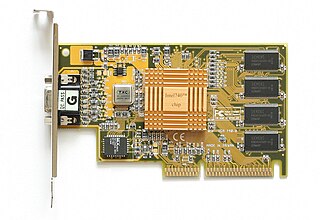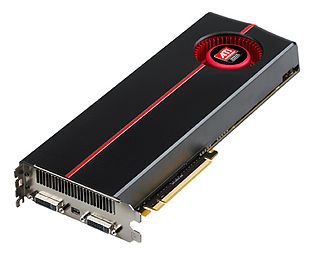
Accelerated Graphics Port (AGP) is a parallel expansion card standard, designed for attaching a video card to a computer system to assist in the acceleration of 3D computer graphics. It was originally designed as a successor to PCI-type connections for video cards. Since 2004, AGP was progressively phased out in favor of PCI Express (PCIe), which is serial, as opposed to parallel; by mid-2008, PCI Express cards dominated the market and only a few AGP models were available, with GPU manufacturers and add-in board partners eventually dropping support for the interface in favor of PCI Express.

A motherboard is the main printed circuit board (PCB) in general-purpose computers and other expandable systems. It holds and allows communication between many of the crucial electronic components of a system, such as the central processing unit (CPU) and memory, and provides connectors for other peripherals. Unlike a backplane, a motherboard usually contains significant sub-systems, such as the central processor, the chipset's input/output and memory controllers, interface connectors, and other components integrated for general use.

The VESA Local Bus is a short-lived expansion bus introduced during the i486 generation of x86 IBM-compatible personal computers. Created by VESA, the VESA Local Bus worked alongside the then-dominant ISA bus to provide a standardized high-speed conduit intended primarily to accelerate video (graphics) operations. VLB provides a standardized fast path that add-in (video) card makers could tap for greatly accelerated memory-mapped I/O and DMA, while still using the familiar ISA bus to handle basic device duties such as interrupts and port-mapped I/O. Some high-end 386DX motherboards also had a VL-Bus slot.

In computing, an expansion card is a printed circuit board that can be inserted into an electrical connector, or expansion slot on a computer's motherboard to add functionality to a computer system. Sometimes the design of the computer's case and motherboard involves placing most of these slots onto a separate, removable card. Typically such cards are referred to as a riser card in part because they project upward from the board and allow expansion cards to be placed above and parallel to the motherboard.

A graphics card is a computer expansion card that generates a feed of graphics output to a display device such as a monitor. Graphics cards are sometimes called discrete or dedicated graphics cards to emphasize their distinction to integrated graphics processor on the motherboard or the CPU. A graphics processing unit (GPU) that performs the necessary computations is the main component in a graphics card, but the acronym "GPU" is sometimes also used to refer to the graphics card as a whole.

The SGI Indigo2 and the SGI Challenge M are Unix workstations which were designed and sold by SGI from 1992 to 1997.
The SGI Origin 350 is a mid-range server computer developed and manufactured by SGI introduced in 2003. Their discontinuation in December 2006 brought to a close almost two decades of MIPS and IRIX computing.

The Intel740, or i740, is a 350 nm graphics processing unit using an AGP interface released by Intel on February 12, 1998. Intel was hoping to use the i740 to popularize the Accelerated Graphics Port, while most graphics vendors were still using PCI. Released to enormous fanfare, the i740 proved to have disappointing real-world performance, and sank from view after only a few months on the market. Some of its technology lived on in the form of Intel Extreme Graphics, and the concept of an Intel produced graphics processor lives on in the form of Intel HD Graphics and Intel Iris Pro.

The GeForce 7 series is the seventh generation of Nvidia's GeForce graphics processing units. This was the last series available on AGP cards.

SPARCstation 5 or SS5 is a workstation introduced by Sun Microsystems in March 1994. It is based on the sun4m architecture, and is enclosed in a pizza-box chassis. Sun also offered a SPARCserver 5 without a framebuffer. A simplified, cheaper version of the SS5 was released in February 1995 as the SPARCstation 4. Sun also marketed these same machines under the "Netra" brand, without framebuffers or keyboards and preconfigured with all the requisite software to be used as web servers. An estimated 400,000+ SPARCstation 5s were sold.

Graphics hardware is computer hardware that generates computer graphics and allows them to be shown on a display, usually using a graphics card in combination with a device driver to create the images on the screen.

The Intel 440BX is a chipset from Intel, supporting Pentium II, Pentium III, and Celeron processors. It is also known as the i440BX and was released in April 1998. The official part number is 82443BX.

The IBM BladeCenter was IBM's blade server architecture, until it was replaced by Flex System in 2012. The x86 division was later sold to Lenovo in 2014.
The graphics address remapping table (GART), also known as the graphics aperture remapping table, or graphics translation table (GTT), is an I/O memory management unit (IOMMU) used by Accelerated Graphics Port (AGP) and PCI Express (PCIe) graphics cards. The GART allows the graphics card direct memory access (DMA) to the host system memory, through which buffers of textures, polygon meshes and other data are loaded. AMD later reused the same mechanism for I/O virtualization with other peripherals including disk controllers and network adapters.
Serial Digital Video Out (SDVO) is a proprietary Intel technology introduced with their 9xx-series of motherboard chipsets.

The Intel 810 chipset was released by Intel in early 1999 with the code-name "Whitney" as a platform for the P6-based Socket 370 CPU series, including the Pentium III and Celeron processors. Some motherboard designs include Slot 1 for older Intel CPUs or a combination of both Socket 370 and Slot 1. It targeted the low-cost segment of the market, offering a robust platform for uniprocessor budget systems with integrated graphics. The 810 was Intel's first chipset design to incorporate a hub architecture which was claimed to have better I/O throughput and an integrated GPU, derived from the Intel740.

The Personal Computer Series, or PC Series, was IBM's follow-up to the Personal System/2 and PS/ValuePoint. Announced in October 1994 and withdrawn in October 2000, it was replaced by the IBM NetVista, apart from the Pentium Pro-based PC360 and PC365, which were replaced by the IBM IntelliStation.
In computing, the motherboard form factor is the specification of a motherboard – the dimensions, power supply type, location of mounting holes, number of ports on the back panel, etc. Specifically, in the IBM PC compatible industry, standard form factors ensure that parts are interchangeable across competing vendors and generations of technology, while in enterprise computing, form factors ensure that server modules fit into existing rackmount systems. Traditionally, the most significant specification is for that of the motherboard, which generally dictates the overall size of the case. Small form factors have been developed and implemented.
The Origin 3000 and the Onyx 3000 is a family of mid-range and high-end computers developed and manufactured by SGI. The Origin 3000 is a server, and the Onyx 3000 is a visualization system. Both systems were introduced in July 2000 to succeed the Origin 2000 and the Onyx2 respectively. These systems ran the IRIX 6.5 Advanced Server Environment operating system. Entry-level variants of these systems based on the same architecture but with a different hardware implementation are known as the Origin 300 and Onyx 300. The Origin 3000 was succeeded by the Altix 3000 in 2004 and the last model was discontinued on 29 December 2006, while the Onyx 3000 was succeeded by the Onyx4 and the Itanium-based Prism in 2004 and the last model was discontinued on 25 March 2005.
This glossary of computer hardware terms is a list of definitions of terms and concepts related to computer hardware, i.e. the physical and structural components of computers, architectural issues, and peripheral devices.














